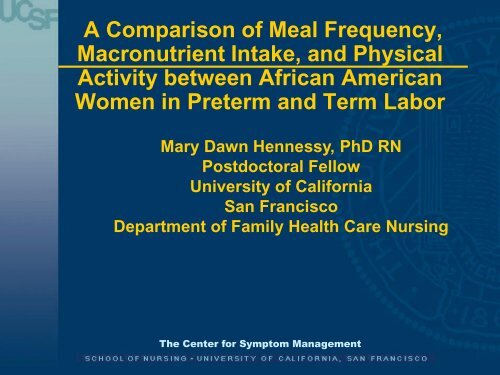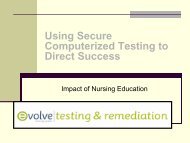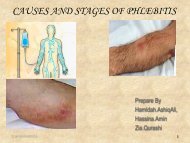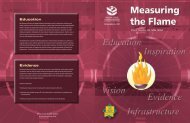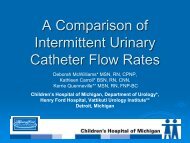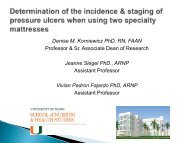Hennessy, Mary Dawn - IUPUI
Hennessy, Mary Dawn - IUPUI
Hennessy, Mary Dawn - IUPUI
You also want an ePaper? Increase the reach of your titles
YUMPU automatically turns print PDFs into web optimized ePapers that Google loves.
A Comparison of Meal Frequency,<br />
Macronutrient Intake, and Physical<br />
Activity between African American<br />
Women in Preterm and Term Labor<br />
<strong>Mary</strong> <strong>Dawn</strong> <strong>Hennessy</strong>, PhD RN<br />
Postdoctoral Fellow<br />
University of California<br />
San Francisco<br />
Department of Family Health Care Nursing<br />
The Center for Symptom Management
Background<br />
• Prolonged periods without food, decreased<br />
macronutrient intake, and certain types of<br />
physical activity associated with preterm<br />
birth<br />
• No studies to date have linked these<br />
variables with preterm labor<br />
• Not known how frequent these behaviors<br />
are in African Americans<br />
(Herrmann et al., 2001; Kafatos et al., 1996; Siega Riz et al., 2001)<br />
The Center for Symptom Management
African American Women and<br />
Preterm Labor<br />
• Approximately 100,000 African American<br />
women deliver prematurely each year<br />
• African Americans have a prematurity rate<br />
of 16% to 18% compared to 7% to 9% for<br />
Caucasian women<br />
(Goldenberg, 2002)<br />
The Center for Symptom Management
Preterm Labor vs. Preterm Birth<br />
• Spontaneous preterm labor is responsible<br />
for 40% to 50% of preterm birth<br />
(Goldenberg, 2002)<br />
The Center for Symptom Management
Cost of Preterm Labor<br />
• Total costs for preterm labor hospitalization<br />
are estimated in excess of $820 million/year<br />
• Tocodynameter and cervical evaluation<br />
• IV therapy with normal saline and/or<br />
magnesium sulfate<br />
• Disrupt household responsibilities, such as<br />
child care<br />
• If employed, may affect income<br />
(Nicholson et al., 2000)<br />
The Center for Symptom Management
Nutrition during Pregnancy<br />
• Institute of Medicine recommends pregnant<br />
women consume three meals and three<br />
snacks every day during gestation<br />
• 42% report 10 to 12 hours without food, and<br />
48% reported ≥ 13 hours without food<br />
• African American women tend to consume<br />
less nutrient dense foods<br />
(IOM, 1992; Herrmann et al., 2001; Siega Riz et al., 2002)<br />
The Center for Symptom Management
Study Aim<br />
• The aim was to compare<br />
• meal frequency<br />
• macronutrient intake<br />
• physical activity<br />
between African Americans with preterm<br />
labor and those without preterm labor<br />
The Center for Symptom Management
Study Design<br />
• Prospective<br />
• Cross-sectional<br />
• Descriptive<br />
The Center for Symptom Management
Sample Size Calculation<br />
• Meal frequency primary outcome<br />
• Power calculation based on 30% difference<br />
between groups<br />
• Alpha = 0.05, power 80%<br />
• n = 80 (40 per group)<br />
(Herrmann et al., 2001; Siega Riz et al., 2001)<br />
The Center for Symptom Management
• African American<br />
Inclusion Criteria<br />
• ≥ 18 years of age<br />
• 24 to 34 weeks gestation<br />
• English speaking<br />
The Center for Symptom Management
• Hepatitis B<br />
Exclusion Criteria<br />
• Diabetes<br />
• Twin gestation<br />
• Uterine anomalies<br />
The Center for Symptom Management
Data Collection<br />
• 24 to 34 weeks gestation<br />
• Block 2005 Food Frequency Questionnaire<br />
• Three 24-hour diet recalls (two weekdays<br />
and one weekend day)<br />
• International Physical Activity<br />
Questionnaire- long form<br />
• Perceived Stress Scale<br />
The Center for Symptom Management
Data Analyses<br />
• Data entered into Excel spreadsheet<br />
• SAS (JMP, version 7.01, 2007)<br />
• Alpha level 0.05 considered criteria for<br />
statistical significance in all analyses<br />
The Center for Symptom Management
Group Comparisons<br />
• Descriptive statistics<br />
• Differences between groups<br />
• chi-square test for categorical data<br />
• t-test for continuous data<br />
• Mann-Whitney U if continuous data not<br />
normally distributed<br />
The Center for Symptom Management
Model<br />
• Multivariable logistic regression model for<br />
prolonged periods without food (≥ 13<br />
hours) was used to examine if group<br />
(preterm vs. term) was still significantly<br />
associated with outcome after adjustment<br />
for potentially important confounding<br />
variables<br />
The Center for Symptom Management
Demographics<br />
The Center for Symptom Management
Hours Between Meals of Preterm<br />
and Term Groups<br />
The Center for Symptom Management
Weekly Macronutrient Intake of<br />
Preterm and Term Groups<br />
The Center for Symptom Management
Percent of Women<br />
Total Walking for Preterm and<br />
Term Groups<br />
60<br />
50<br />
40<br />
30<br />
20<br />
Term<br />
Preterm<br />
10<br />
0<br />
0-343 344-693 694-2795 2796-13365<br />
MET-minutes/week<br />
*p < 0.05<br />
The Center for Symptom Management
Meal Frequency<br />
Logistic Regression<br />
The Center for Symptom Management
Limitations<br />
• Cross-sectional design<br />
• Recruitment at time of preterm labor<br />
diagnosis<br />
• Subjective reports of physical activity<br />
The Center for Symptom Management
Contributions of Current Study<br />
• Skipping meals and sustaining prolonged<br />
periods without food may be one of the<br />
pathways that initiate preterm labor<br />
• Focus on a particular group of vulnerable<br />
women<br />
The Center for Symptom Management
Future Research<br />
• Prospective studies examining changes in<br />
meal frequency occurring prior to the onset<br />
of preterm labor<br />
• Biochemical analyses, such as serum and<br />
urine analyses for glucose and ketone<br />
concentrations<br />
• Accelerometer captures broader range of<br />
physical activity<br />
The Center for Symptom Management
Implications for Practice<br />
• Pregnancy is a unique time for behavior<br />
modification<br />
• Opportunity for nurses to communicate<br />
importance of frequent meals and snacks<br />
throughout the day and health benefits of<br />
walking as a form of physical activity<br />
The Center for Symptom Management
Acknowledgments<br />
• Sigma Theta Tau, Xi Chapter Grant<br />
• Stella L. Volpe, PhD RD<br />
• Kathy Lee, PhD RN FAAN<br />
The Center for Symptom Management
References<br />
• Goldenberg RL. The management of preterm labor. Obstet Gynecol 2002;100:1020-37<br />
• Herrmann TS, Siega-Riz AM, Hobel CJ, Aurora C, Dunkel-Schetter C. Prolonged periods<br />
without food intake during pregnancy increase risk for elevated maternal corticotropin-releasing<br />
hormone concentrations. American Journal of Obstetrics and Gynecology 2001;185:403-412<br />
• Institute of Medicine (U.S.). Committee on Nutritional Status During Pregnancy and Lactation.<br />
Subcommittee for a Clinical Application Guide. Nutrition During Pregnancy and Lactation: An<br />
implementation guide. Washington, D.C.: National Academy Press; 1992<br />
• Kafatos AG, Vlachonikolis IG, Codrington CA. Nutrition during pregnancy: the effects of an<br />
educational intervention program in Greece. Am J Clin Nutr 1989;50:970-9<br />
• Nicholson, WK, Frick, KD, & Powe, NR. Economic burden of hospitalizations for preterm<br />
labor in the United States. Obstet Gynecol 2000;96;95-101<br />
• Siega-Riz AM, Bodnar LM, Savitz, DA. What are pregnant women eating Nutrient and food<br />
group differences by race. American Journal of Obstetrics and Gynecology 2002;186:480-486<br />
• Siega-Riz AM, Herrmann TS, Savitz DA, Thorp JM. Frequency of eating during pregnancy and<br />
its effect on preterm delivery. American Journal of Epidemiology 2001;153:647-652<br />
The Center for Symptom Management


